Reproduced by permission of the author - Ron Flynn
Is Your Audubon Print an Original?
Illustrated Print Identification and Authentication
by Ron Flynn
There were five different original Audubon publications between 1826-1871. Most of these publications had only one edition, but one had four editions, and another up to eight editions. Each original Audubon publication was printed on a specific sized sheet of paper with the image either horizontally or vertically oriented. Virtually all original Audubon bird and animal images were trimmed slightly and bound into a book volume, as a bookplate. Original Audubons were sold by subscription, and the subscriber generally had them bound into book volumes. However, for each original Audubon publication, there exist a few examples that were never bound into book volumes, and will be slightly larger than the specific paper sizes listed later in this article. For all original Audubon publications, and all their editions, there are an estimated 3.4 million original Audubon plates/prints in existence. (They are called bookplates while still bound into book volumes, and referred to as prints when removed from their original book volumes). Very many of the original Audubons remain in their original bound book volume form, and are owned by libraries, museums, institutions, and private collectors.
There are fewer than ten limited edition publications of high quality Audubon facsimile reproduction prints that have been issued (and several are not yet sold out) of the original full sized D.E.F. (Double Elephant Folio 26-1/2" x 39-1/2" +/-) Birds of America prints, since the 1930s. These all have some monetary worth to collectors, and have market values of from less than $100 to several thousand dollars per print. Please read my article about Modern Audubon D.E.F. Editions on this website. The total number of these limited edition prints that have been produced is around 400,000.
Finally, there are an estimated 20-25 million cheap low quality Audubon reproduction prints that have been produced since the 1930s, and ALL have little or no market value. There is virtually no demand for these inexpensive reproductions, and no Audubon dealers sell them. More and more are produced each year, and asking prices are ridiculously high. You can usually find scores of these cheap reproductions listed on eBay, for various prices, to unknowing or unsuspecting buyers. Many are offered framed, and their value generally is what the used frame is worth. Beginning in the 1930s, several different editions of Birds of America were produced. These picture books had illustrations of the original Audubon prints, but were produced by modern color offset lithography. People take these books apart and attempt to sell the pictures from these books. Beginning in the 1940s, banks and insurance companies, particularly Northwestern Mutual Life, printed millions of cheap reproductions and gave them away to their customers. Other companies and even the Audubon Society itself produced calendars illustrated with cheap reproductions of the original Audubon prints.
It's Called Authentication -
So, you've just discovered a box of Audubon prints in the attic or basement, or you inherited or were given an Audubon print from Granny or Aunt Betsy that's been hanging on her wall for 40 or 50 years, or you went to an estate or garage sale and bought this beautiful Audubon print. Now you want to know if what you have is an original Audubon print, that is one of those rare finds you see on the Antique Roadshow, or is it a cheap reproduction with little or no value. And, of course, you also want to know how much your Audubon print is worth. I'll deal with how much your print is worth later in this article. First, you must determine if what you have is an original Audubon print.
The first thing you must do is to try as hard as you reasonably can to determine if your prints are truly original Audubon prints. This is called authentication, and this article will help you immensely. Self-education and self-help are your main tools. You do not want to be embarrassed by trying to sell a fistful of cheap Audubon reproductions to a veteran print dealer, and you don't want to pay $100 or more for a professional appraisal of reproduction prints that are barely worth a few dollars apiece. You want to be at least 90% certain that you have original Audubon prints before you pester a print dealer to authenticate, value and/or buy them. Yes, I said pester. Please read on to find out what I mean, and what you might encounter.
If there is one single thing that print dealers regularly complain about, it is the high numbers of people who contact them to have their "Audubon" prints identified, authenticated, evaluated or appraised for FREE! Many print dealers will say that over 75% of these requests will turn out to be cheap Audubon reproductions. It takes time for a dealer to examine prints, and even more time to write a report letter or formal appraisal. Dealers are not going to do this for FREE. In fact, Audubon print collecting has become extremely popular in the past few years, and now many print dealers will no longer authenticate or appraise prints, even for a fee. There are still a few dealers who will do print authentication and appraisals for a fee. There are numerous independent art appraisers who will do this for a fee of usually 10% of their appraised value. You would want to authenticate a print to determine if it is an original Audubon print, or one of the reproductions, with or without much value. In over 90% of all cases, you can do this yourself with the information in this article.
Self-authentication -
There are three simple things that will separate inexpensive reproductions from original Audubon prints: size of the paper, dots, and extra printed text. First, as stated previously, each of the original Audubon Editions was printed on a specific size of paper. These paper sizes are given below for each of the 5 original Audubon publications. However, if your "Audubon" print measures one of the modern familiar paper sizes (8" x 10", 8-1/2" x 11", 10" x 14", 10" x 16", etc.) you can be certain it is an inexpensive reproduction.
Next, with the exception of the very rare Bien Edition (chromolithographs), all original Audubon Editions were hand colored, using watercolor paints of the era. For detailed information on the Bien Edition chromolithographs read my article about this edition on this website. Tiny colored dots are a dead giveaway of a reproduction. You should closely examine any Audubon print using a 10x jeweler's loupe or hand magnifier. If you see that the print is made up of millions of tiny colored dots, you have a modern reproduction produced by color offset lithography or computer printing. If you have a hand colored original, the colors will be smooth and solid, and you might see brush strokes. Where two colors meet, in a hand colored original, the different colors may not touch perfectly and there might be minute gaps, or two hand painted colors might overlap ever so slightly.
Finally, virtually all reproductions will be printed with most or all of the text information and credits found on an original Audubon print. However, if a print has additional printed text such as: issued by xxx, printed by or for xxx, etc., it is an obvious reproduction. Quite a large number of reproductions will have the name of a bank or insurance company printed somewhere on the print.
If you have measured your "Audubon" print for standard modern sized sheets of paper, checked under magnification for tiny colored dots, and checked for additional identifying text information, you are well on your way to determining if your Audubon print is an original. Below, you will find detailed descriptions and illustrations of the original Audubon publications. After that, you will find information on how to determine the general market value of your original Audubon print.
The Original Audubon Publications
Birds of America Havell Edition (1826-38) The 1st original Audubon publication. Some of the first 10 prints in the series were produced in Scotland by Lizars, and the remainder were produced in London by R. Havell and/or his son (Jr.). There were 435 different prints in this publication, and an estimated 180 complete sets of 435 were produced. Today, about 110 of these sets remain intact as bound book volumes owned by museums, institutions, and private individuals. The last recorded sale for a complete 4 volume bound set was $8.8 million. Individual prints sell for from several thousand dollars each up to $200,000.00 or more. These are the most widely and frequently reproduced and copied of all the original Audubon prints.
The Audubon Havell Edition prints are hand colored aquatint copper-plate engravings. Each print will have a plate mark, a colorless rectangular depression in the paper created by the extreme pressure used in the printing process. The paper is somewhat heavy, yet supple enough to be rolled. The paper will have a watermark, visible when held up to a light source (see Fig. 1), either J. Whatman or J. Whatman Turkey Mills, plus a year. Full sized original prints would measure about 26-1/2" x 39-1/2" (this size is extremely important in distinguishing from reproductions) if originally bound into a volume (or slightly larger if never bound into a book), and might have tiny holes or slits along one edge, where the print was stitched into a book volume. A plate # was printed in the upper right corner in Roman numerals. Generally, plate #s ending in I or VI (1 or 6) had one large bird on each print, which took up most of the sheet of paper, as ALL birds were printed life sized. Prints ending with plate #s of II or VII (2 or 7) generally had images of one medium sized bird. The remaining prints, or about 60% of all Havell Edition prints, had relatively small images of songbirds on a large sheet of paper. It was not uncommon to trim or fold these prints so they would fit into a smaller less expensive frame. If more than 1” or 2” of the above dimensions have been trimmed from these very rare original prints, their value would be appreciably reduced. If an original Havell Edition print were trimmed so that there was no evidence of the plate mark or watermark, this is one rare case where you cannot positively self-authenticate the originality of the print, and the print should be professionally authenticated. Fig. 2 shows an original Audubon Havell print.

Fig. 1 Birds of America Havell Edition watermarks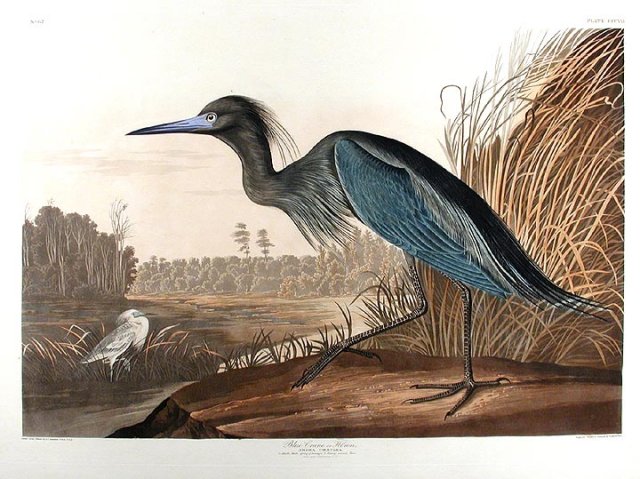
Fig. 2 Birds of America Havell Edition plate #CCCVII (307) Blue Crane or Heron
Birds of America Octavo Editions (1840-71) There were up to eight different octavo editions, each containing 500 different hand colored stone lithographs. There is no plate mark or watermark. The paper is white and somewhat stiff like card stock. Each print should measure about 6-1/2" x 10-1/2" after being removed from its original book volume. Each print should have what is called a binding edge or strip along one edge of the paper, with tiny holes or slits as evidence of the print having been stitched into a book, and a narrow strip where a tissue guard was glued on to protect the image. It is common and routine for dealers and other sellers of original Audubon octavo prints, to sell them with the binding edge intact (see left edge in Fig. 6). If these prints have been trimmed, and the binding edge is missing, the value of these prints is somewhat reduced. All prints have a plate number printed in Arabic numerals in the upper right corner. Larger reproductions of these prints are seldom seen. However, several picture books were published after the 1930s in which some or all 500 of the prints were produced as inexpensive color offset lithographs on inexpensive paper. Individual original octavo prints retail from under $50 each up to around $3,000.00 each. 1st edition prints, of a particular bird, are more valuable than the 2nd or later edition prints of the same bird.
The 1st edition was published between 1840-44. All 1st edition prints were lithographed and colored by J.T. Bowen of Philadelphia and New York, EXCEPT plate #s 136-150, which were lithographed and colored by George Endicott. The vast majority of the 500 prints were of the bird(s) on a branch or bird(s) on the ground type image (see Fig. 3). A few of the 500 prints had a solid hand colored background with some sort of setting for the bird (see Fig. 4). Finally, some of the 500 prints had an elaborately hand colored landscape or habitat scene (see Fig. 5). 1st edition prints are distinguished and recognized by the ABSENCE of a printed color background (see below) At my other website, www.audubonprices.com , I sell a CD, Images of Audubon, which has images of all 500 octavo 1st edition prints.
All 2nd and later octavo edition prints have an aqua or beige printed colored background, either as a solid rectangle (see Fig. 6), or with white areas in most scenes, supposedly to resemble clouds and sky (see Fig. 7). However, while it is easy to identify 1st edition prints, it is virtually impossible to determine which of the up to 7 other octavo editions a print with a printed colored background is from, once it has been removed from its original bound volume.
Birds of America 1st Octavo Edition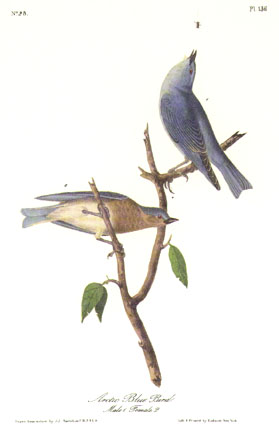
Fig. 3 plate #136 Arctic Bluebird
Typical bird/branch image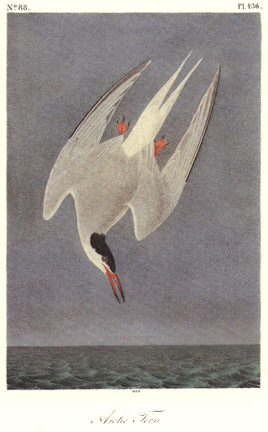
Fig. 4 plate # 436 Arctic Tern
Hand colored rectangular background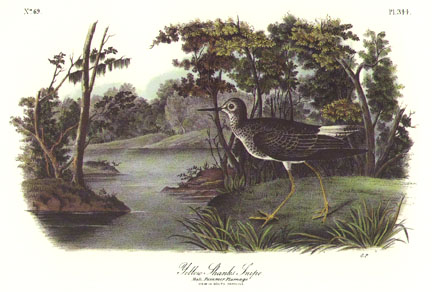
Fig. 5 plate #344 Yellow Shanks Snipe
Hand colored habitat scene
Birds of America 2nd and Later Octavo Editions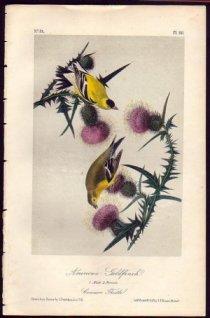
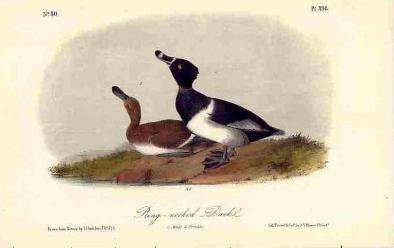
Fig. 6 Plate #181 American Goldfinch Fig. 7 Plate # 398 Ring-necked Duck
Notice the printed colored background in later Edition Octavo Bird prints
The Viviparous Quadrupeds of North America (1845-48) This publication consisted of 150 different prints of quadruped (four footed) mammals, and is referred to as the Imperial Folio Edition. It was published in three volumes of 50 prints each in 1845, 1846 and 1848 respectively. The prints were hand colored stone lithographs printed on unwatermarked heavy supple off-white paper. Paper size, as removed from the original book volume, should measure about 22" x 28" with the binding edge intact, though it is more common to find individual prints with the narrow binding edge trimmed off. There is evidence of a 2nd edition that was published sometime after the Civil War, by Lockwood, in two volumes of 75 prints each. Of the few known 2nd edition volumes, it is said that the paper and hand coloring are inferior to the 1st edition prints.
The plate # is printed in Roman numerals in the upper right corner. All prints were lithographed and colored by J.T.Bowen. In the lower left corner, about half of the 150 different prints are credited to J.J. Audubon, and the remainder are credited to his son, J.W. Audubon. A good number of the 150 different original Audubon Imperial Folio prints sell for between $500.00 and $1,000.00, but a few prints sell for over $30,000.00 each. Fig. 8 and Fig. 9 illustrate both horizontal and vertical prints from this original Audubon publication. There are few inexpensive off-sized reproductions of these prints. Princeton-Audubon Ltd. is selling high quality 22" x 28" facsimile reproductions of about 12 of these prints.
The Viviparous Quadrupeds of North America (1845-48) folio prints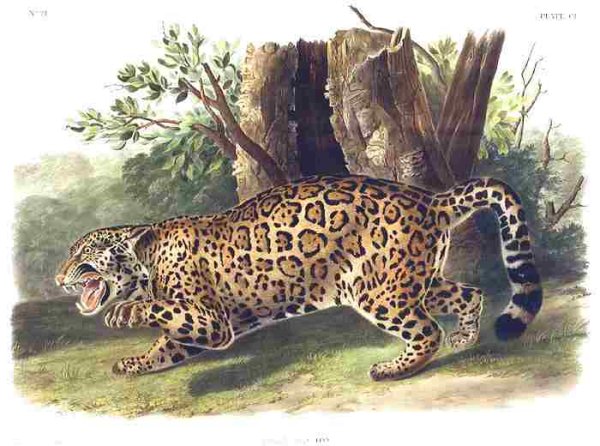
Fig. 8 Plate # CI (101) The Jaguar Imperial Folio Edition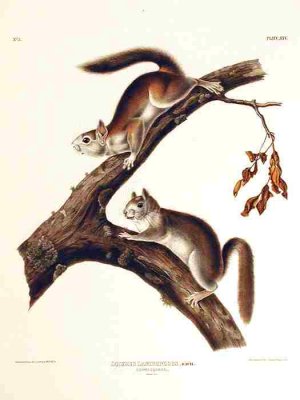
Fig. 9
Plate #XXV (25)
Downey Squirrel
Imperial Folio Edition
The Quadrupeds of North America Octavo Editions (1849-71) There were four different original Audubon octavo editions published between 1849-1871, each consisting of 155 different hand colored stone lithographs issued in three volumes. There is no plate mark or watermark on the print. The white paper is somewhat stiff, like a card stock. Each print should measure about 7" x 10-1/2" to 11" after removal from its original book volume, and should have what is called a binding edge along one side, with tiny holes or slits as evidence of the print having been stitched into a book, and evidence of a narrow glue strip where a tissue guard was glued on to protect the image. If the binding edge has been trimmed off, the value of the print is somewhat reduced. All prints in all editions have an aqua or beige printed color background (see Figs. 10 and 11) that is either a solid rectangle, or with white patches to resemble clouds and sky in landscape scenes. All are finished with hand applied watercolor paints of the era.
Plate numbers are printed in Roman numerals in the upper right corner of each print. A credit to the lithographer is printed in the lower right corner. Early prints of plate #s 1-26 and 29-31 will have a credit to Nagel & Weingaertner of New York. Later prints of the above plate #s, as well as all other prints will be lithographed and colored by J.T. Bowen. In the lower right hand corner a credit will be printed for the original artist of the drawing which was made into the print. About half of the 155 different prints will be credited to J.J. Audubon, and the remainder credited to J.W. Audubon, J.J.'s son.
Once separated from their original bound volume, it is virtually impossible to determine which edition a print is from. Dealers sell 1st edition octavo quadruped prints at a premium, but the printed color backgrounds and images are all identical for all editions. There are numerous variants or "states" in the text credits (or the lack thereof) on these prints. Please read my article Audubon Print States Versus Editions on this website. Other than implicitly trusting a dealer, the only certainty of a true 1st edition are found in plate #s 1-26 and 29-31 that have a credit to Nagel & Weingaertner.
At my other website, www.audubonprices.com , I sell a CD that includes all 155 images in the Quadrupeds of North America series. Original Audubon prints from this publication retail from $50.00 to over $1,000.00 each. Most of the inexpensive reproductions of this publication come from picture books published since the 1930s.
The Quadrupeds of North America Octavo Editions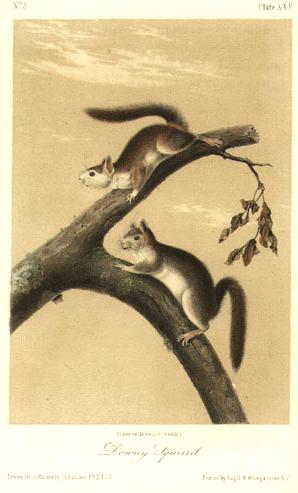
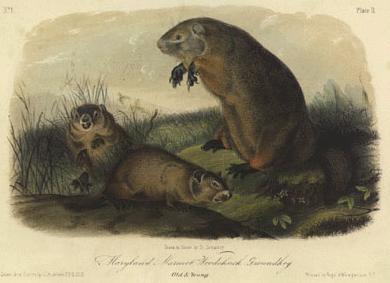
Fig. 10 Plate # XXV (25) Downey Squirrel Fig. 11 Plate # II (2) American Marmot or Woodchuck
Notice the printed colored background in all Quadruped Octavo Editions
Birds of America Bien Edition (1858-60) The original Audubon Bien Edition consisted of 150 different printed images on 105 different sheets measuring about 26-1/2" x 39-1/2". Many of the original sheets contained 2 images, and they were frequently separated into two smaller sheets. Each print was a stone lithographed ink chromolithograph. That is, each image was printed with ink from 6 to as many as 15 different stones, one for each color. Sometimes the final prints were touched up or finished with some hand applied watercolor paints. It is estimated that only 75 sets of this publication were completed before the Civil War halted production. In terms of numbers, the Bien Edition is the rarest of all original Audubon publications. However, the market value of prints in the Havell Edition far exceed those of the Bien Edition. Full Bien Edition sheets retail from a couple thousand dollars each on up to $40,000.00 or more. There are extremely few reproductions of this very rare edition. For complete details on this edition, please read my article, The Audubon Bien Edition on this website.
Other information -
Remarkably, there are relatively few major variants or "states" among all of the above original Audubon editions, due to purposeful changes in the actual printed image. Except for the chromolithographed Bien Edition, the other original Audubon editions were hand colored. Because of the personal hand coloring by different artists or colorists, you may find subtle differences in coloring, when identical prints are compared. These differences would not constitute a new or different "state". However, you will find more true different "states", among all original Audubon editions, as a result of changes to the printed text credits. Some of the common text credit "states" that were created purposely or by omission include: either block or italics text fonts, credits for different lithographers, including or not including credits for engravers or colorists, initials of favored colorists, and the printing of plates with various missing credits. All else equal, original Audubon prints do have different variants or "states' within each edition. They are still original Audubon prints. These different "states" occur most often in the Quadrupeds of North America Octavo Editions, and the early Birds of America Havell Edition.
The Value of Original Audubon Prints
The value of original Audubon prints is based upon three factors: the relative rarity of the print edition, the popularity of the particular print within that edition, and the actual condition of the print. There are three common values for any Audubon print. First, there is the retail value, which is the price dealers sell the print for. This varies widely around the Country based on many factors, including dealer markup and overhead. Secondly, there is the wholesale value, or the amount a dealer would pay you for your print. Based upon the above three factors, this could be 30%-70% of retail value. Finally, there is the replacement value for insurance purposes. Depending on your insurance company, this value could be: the average dealer price from around the Country, the highest dealer price found for that print, or what you paid for that print times a percentage of perhaps 110%.
Although I am now retired and no longer a print dealer, I still receive about 5-6 email requests or images a week, wanting authentication or valuation of "Audubon" prints. Would you be surprised if I told you that almost all of these unsolicited requests, to me, seem quite insistent, indignant and border on being rude. It is as if it's my fault and I owe them something for FREE. Print dealers I know have similar experiences. My answer to you, and those unsolicited requests, is that authentication cannot be done via an email image. I do not do print identifications, authentications, valuations or appraisals. PLEASE DO NOT CALL OR EMAIL ME WITH THESE TYPE REQUESTS. Many print dealers will say the same to you. It is much more likely that the "Audubon" print you found in a dumpster, was given to you in an inexpensive frame, bought at a garage sale or flea market, etc., is an inexpensive reproduction.
In regards to providing a valuation for "Audubon" prints, I publish numerous FREE informative related articles about Audubon prints here on this website, and I sell various products dealing with the market value of all original Audubon print editions at www.audubonprices.com . My Price Guides for individual Audubon editions, are extremely well researched, and reasonably priced at $12.50 or less PPD, or sent via email for $10.00 or less. They will provide you with a researched basis for the market/replacement value of each and every original Audubon print. Rather than paying for a specific appraisal for your Audubon print, at relatively high fees, my individual Audubon Price Guides will provide you with information and prices, so that you can determine the market value of your Audubon print, and supply that information to your insurance company to get scheduled art insurance coverage.
Other resources -
If you cannot visit a local dealer, then a trip to a medium-large library should yield some good Audubon books. The books and links below may prove useful and interesting.
Audubon, John James. Birds of America. Several publishers and editions
Audubon, John James. Quadrupeds of North America. New Jersey. Wellfleet Press. 1989
Bannon, Lois Elmer and Clark, Taylor. Handbook of Audubon Prints. Gretna, LA. Pelican Publishing, 1998
Braun, Robert. Identifying Audubon Bird Prints. Originals, States, Editions, Restrikes, and Facsimiles and Reproductions. Published in Imprint, the Journal of the American Historical Print Collectors Society. [Volume 21, Number 2.] Fairfield, CT. 1996.
Flynn, Ron. An Introduction to Audubon and the Octavo Editions. Published on the Internet @ www.auduboninfo.net
Flynn, Ron. Audubon Octavo Print “States” Versus “Editions”. Published on the Internet @ www.auduboninfo.net
Flynn, Ron. Buying Audubon Prints and Print Condition. Published on the Internet @ www.auduboninfo.net
Flynn, Ron. The Audubon Bien Edition. Published on the Internet @ www.auduboninfo.net
Fries, Waldemar. The Double Elephant Folio. Chicago. American Library Association. 1973, A reprint edition is now available.
Low, Susanne M. A Guide to Audubon's Birds of America. New York. William Reese Co. 2002
Low, Susanne M. An Index and Guide to Audubon’s Birds of America. New York. Abbeville Press. 1988
Steiner, Bill. Audubon Art Prints. South Carolina. University of South Carolina Press. 2003
Tyler, Ron. Audubon’s Great National Work. Austin, TX. W. Thomas Taylor. 1993